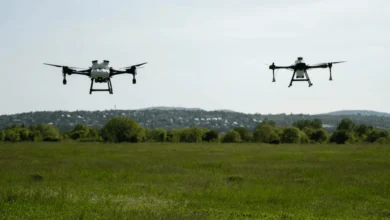Why Every Delivery Driver Needs a GPS Tracker and Dash Cam with GPS

In today’s fast-paced world of logistics and delivery, efficiency, safety, and accountability are paramount. For delivery drivers, managing these factors while navigating challenging conditions requires more than just skill behind the wheel. It requires the right tools. Two essential tools that every delivery driver should have are a GPS Tracker and a Dash Cam with GPS. These technologies not only enhance safety and productivity but also offer significant long-term benefits for both drivers and businesses.
In this blog, we will explore why these tools are indispensable for delivery drivers, how they work together to improve performance, and the numerous advantages they offer. Whether you are a fleet manager, an independent contractor, or a business owner, the combination of a GPS Tracker and dash cam with GPS is an investment that can revolutionize the way you manage deliveries.
The Need for Efficiency in Modern Delivery Operations
In the modern delivery industry, time is money. With the rise of e-commerce and on-demand services, consumers expect faster delivery times than ever before. However, this demand puts immense pressure on drivers, who must navigate busy streets, meet strict delivery schedules, and keep track of multiple stops in a day.
This is where the integration of a GPS Tracker and a dash cam with GPS comes into play. Together, they offer a comprehensive solution for monitoring and optimizing delivery routes, reducing inefficiencies, and ensuring that deliveries are made on time.
Improved Route Planning with a GPS Tracker
One of the most significant advantages of a GPS Tracker is its ability to improve route planning. GPS Trackers provide real-time location data, which can help drivers and fleet managers identify the most efficient routes to take. Whether it’s avoiding traffic, road closures, or construction zones, having access to real-time data can reduce travel time and fuel consumption.
For fleet managers, GPS tracking technology offers the ability to monitor multiple drivers simultaneously. By identifying the most efficient routes in real-time, fleet managers can minimize delays, improve delivery times, and ensure that their vehicles are on track for timely deliveries.
Example: A fleet of delivery trucks in a city with heavy traffic can rely on GPS trackers to be automatically rerouted to avoid congestion, ensuring timely deliveries and saving on fuel costs.
Enhanced Safety with a Dash Cam with GPS
Safety is always a priority for delivery drivers, who face a variety of hazards while on the road. From distracted drivers to adverse weather conditions, a delivery driver’s job is filled with unpredictable challenges. A dash cam with GPS is a powerful tool that can improve safety and provide valuable evidence in the event of an accident.
Dash cams with GPS capabilities record video footage of the road, while also capturing GPS data such as location, speed, and time. This combination of visual and GPS data can prove invaluable in case of accidents or disputes. For example, if a delivery driver gets involved in a traffic collision, investigators can use the dash cam’s footage combined with GPS data to clarify the circumstances and determine fault.
Additionally, dash cams with GPS can serve as a deterrent for dangerous driving behaviors. Knowing that a camera is recording can encourage drivers to follow traffic laws, drive more responsibly, and stay focused on the road. This can help reduce the likelihood of accidents and improve the overall safety record of a fleet or individual drivers.
Accountability and Transparency for Drivers
In the delivery industry, accountability is key. Businesses want to ensure that drivers are taking the most efficient routes, adhering to safety protocols, and completing deliveries on time. Both GPS trackers and dash cams with GPS help businesses track driver performance and hold them accountable for their actions.
For instance, GPS trackers provide fleet managers with detailed insights into a driver’s daily movements. This includes not only the routes taken but also the time spent at each stop, ensuring that deliveries are completed on schedule. If a driver takes a longer route or spends too much time on a single stop, managers can identify and address these inefficiencies.
Meanwhile, a dash cam with GPS offers additional accountability by recording the driver’s behavior behind the wheel. This can include monitoring for aggressive driving behaviors like speeding, harsh braking, or sudden lane changes. Dash cam footage can be reviewed to ensure drivers are operating safely and within company guidelines.
Insurance Benefits and Accident Prevention
Accidents are an unfortunate reality for delivery drivers, and the aftermath can be both financially and legally complicated. Fortunately, dash cams with GPS and GPS trackers can help mitigate the risks associated with accidents.
Having a dash cam with GPS can provide crucial evidence in the event of a collision, protecting both the driver and the company from false claims. In addition, many insurance companies offer discounts to drivers and businesses that use GPS trackers and dash cams, as these technologies help reduce the likelihood of accidents and fraud.
Example: A delivery driver involved in a fender bender can use the footage captured by the dash cam with GPS to prove their innocence. The recorded data showing their speed and location at the time of the incident can help resolve the situation more quickly and avoid potential legal battles.
Improved Customer Experience
In the competitive world of delivery services, customer satisfaction is paramount. A GPS tracker and dash cam with GPS can significantly enhance the customer experience by helping drivers make deliveries on time and in the safest manner possible.
Customers today expect real-time tracking of their packages. By utilizing a GPS tracker, businesses can provide customers with accurate, up-to-the-minute information on the location of their deliveries. This reduces customer anxiety and increases trust in the service.
A dash cam with GPS helps businesses quickly identify delivery issues, resolve problems, and ensure a smooth customer experience.
Fleet Management Optimization
For fleet owners and managers, the ability to oversee a large number of vehicles in real-time is invaluable. GPS trackers provide essential data on vehicle location, speed, and route history. Fleet managers can use this data to identify inefficiencies, optimize routes, and schedule maintenance before issues arise.
A dash cam with GPS can be used to monitor driver behavior, providing visual and data-based insights into how each vehicle is being driven. By combining these two tools, fleet managers can take a data-driven approach. This can help optimize their fleet, reduce fuel costs, improve driver performance, and enhance overall operational efficiency.
How These Tools Protect Delivery Drivers
Lastly, GPS trackers and dash cams with GPS are vital tools for protecting delivery drivers themselves. As drivers work alone on the road, they are vulnerable to theft, accidents, and other risks. A GPS tracker ensures that the vehicle can be located quickly in case of theft, while a dash cam with GPS offers a layer of protection by recording events that could otherwise go unnoticed.
For instance, if someone steals a vehicle, the GPS tracker provides real-time location data that can help law enforcement recover it. Similarly, the dash cam with GPS provides recorded evidence that can be crucial for protecting the driver and their reputation.
Wrapping Up
The combination of a GPS tracker and a dash cam with GPS offers undeniable benefits for delivery drivers, fleet managers, and businesses. From improving efficiency and safety to enhancing accountability and customer satisfaction, these tools provide a comprehensive solution for modern delivery operations. Investing in these technologies is not just about tracking locations and recording footage—it’s about safeguarding the people and assets that make your business successful.
For any delivery operation, big or small, having a GPS tracker and a dash cam with GPS is no longer optional—it’s a necessity. These tools empower drivers to perform their jobs more efficiently and safely, while offering businesses the insights and data they need to thrive in a competitive marketplace.
Also read:






